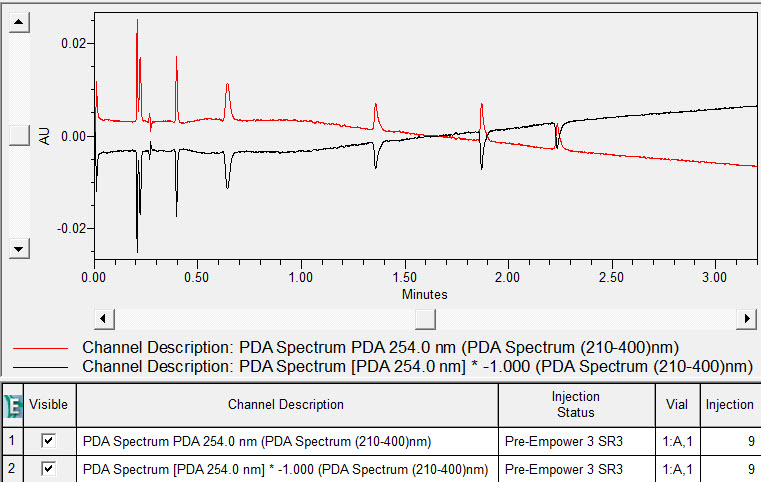How can you make a PDA wavelength that is positive in absorbance negative in absorbance. - WKB106808
Article number: 106808
OBJECTIVE or GOAL
In some instances you may want a negative PDA wavelength absorbance peak to be displayed as a positive peak, or a positive peak absorbance to be displayed as a negative (mirror plot).
This procedure will show you how to reverse the peak direction using Empower 3 and a PDA detector.
ENVIRONMENT
- Empower 3
- Empower 2
- Empower 3 Personal
- Empower 3 Workgroup
- Empower 3 Enterprise
- 2996 PDA Detector
- 2998 Photodiode Array Detector
- ACQUITY UPLC PDA Detector
- ACQUITY UPLC PDA eλ Detector
PROCEDURE
Text instructions below
- In the Empower Project - Make sure the Instrument Method is setup to collect 3D data.
- Edit the Method Set. In the Method Set select:
- Derived Channel - New - Derived Channel First Channel enter PDA Single Wavelength: enter in the desired wavelength
- Select 2nd Channel and in the Operator select * and for the Constant select -1.000
- Save the derived channel as (selected wavelength_negative)
- Save the Method Set.
3. Acquire the 3D Data in the Run Samples window
4. Option A
- Highlight the 3D PDA Channel and select the Review window
- Select File - Open Method Set and then select Apply Method Set.
- The Review Window will display the channel in the opposite direction from how it was acquired,
5. Option B
- Select the Sample Set, Injection or Channel view
- Right Click and select Process
- Select use selected Method Set and select Ok.
- Select the Results tab and highlight the processed results
- Select Review or Preview and the reversed direction chromatogram should be displayed.
ADDITIONAL INFORMATION
id106808, A-30PDA, EMP2LIC, EMP2OPT, EMP2SW, EMP3GC, EMP3LIC, EMP3OPT, EMP3SW, EMPGC, EMPGPC, EMPLIC, EMPOWER2, EMPOWER3, EMPSW, SUP, UPAPDA, UPARPPDA, UPC2PDA, UPPDA, UPPDAARC, UPPDAARCB, UPPDA-E, UPPDA-L, UPPDALTC, UPPDATC, UPPPDA


